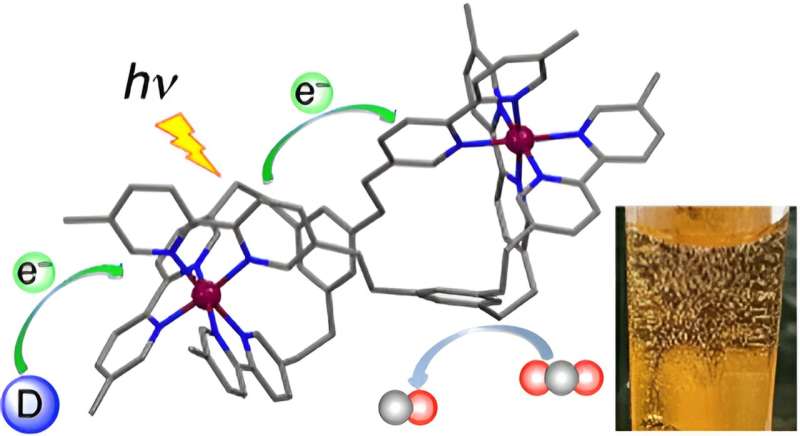This article has been reviewed according to Science X's editorial process and policies. Editors have highlighted the following attributes while ensuring the content's credibility:
fact-checked
peer-reviewed publication
trusted source
proofread
Dinuclear ruthenium complex as a photocatalyst for selective CO2 reduction to CO

Similar to the process of photosynthesis in plants, the conversion and storage of solar energy into chemical energy hold significant promise for addressing critical energy and environmental challenges, including the depletion of fossil fuels and threat of global warming. One promising avenue in this pursuit involves harnessing light energy to convert CO2 into value-added chemicals.
In a recent study, University of Tsukuba researchers harnessed the potent photocatalytic properties of a ruthenium (Ru) dinuclear complex with self-photosensitizing capabilities to achieve a remarkably efficient CO2 reduction reaction. This process yields a high selectivity for carbon monoxide (CO). Their research has been published in the Journal of the American Chemical Society.
When a dimethylacetamide/H2O mixture containing the Ru dinuclear complex as a photocatalyst and a sacrificial reducing agent was exposed to light with a central wavelength of 450 nm in 1 atm CO2 atmosphere for 10 h, all the sacrificial reducing agent was consumed, and the substrate CO2 was converted into CO with a selectivity exceeding 99%.
The maximum quantum yield at 450 nm was determined to be 19.7%. Furthermore, even when the initial CO2 concentration in the gas phase was reduced to 1.5%, the photocatalytic CO2 reduction by the Ru complex proceeded with remarkable efficiency, indicating that nearly all the introduced CO2 could be converted into CO.
In this newly developed Ru dinuclear complex, the two Ru complex moieties engage in photosensitization, enhancing the stability of the complex catalyst under reaction conditions. This enhanced stability is attributed to the extraordinarily strong chelating effect of the ligand employed.
The researchers have future plans for further enhancing the catalytic activity to create a reaction system capable of efficiently driving the CO2 reduction process, even at a lower CO2 concentration equivalent to that of the Earth's atmosphere, which is approximately 420 ppm.
More information: Tomoya Ishizuka et al, Self-Photosensitizing Dinuclear Ruthenium Catalyst for CO2 Reduction to CO, Journal of the American Chemical Society (2023). DOI: 10.1021/jacs.3c07685
Journal information: Journal of the American Chemical Society
Provided by University of Tsukuba





















